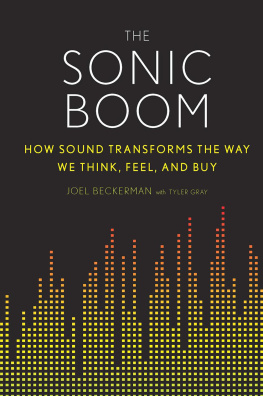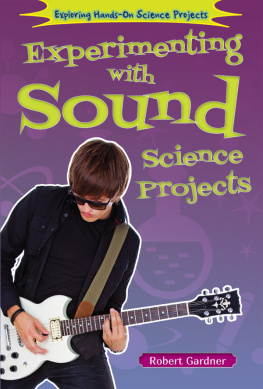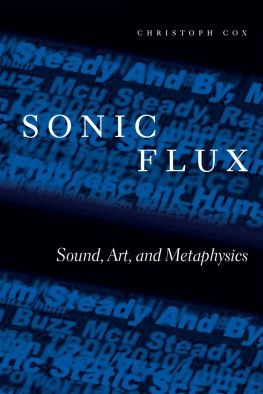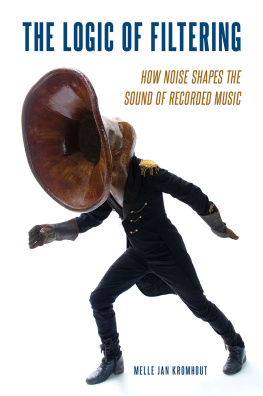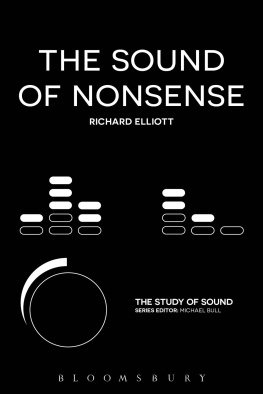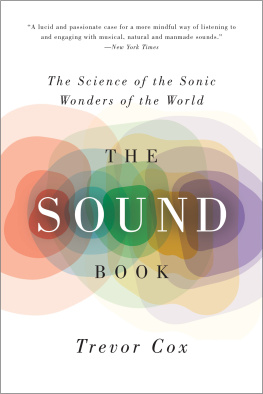Copyright 2014 by Man Made Music, Inc.
All rights reserved
For information about permission to reproduce selections from this book, write to Permissions, Houghton Mifflin Harcourt Publishing Company, 215 Park Avenue South, New York, New York 10003.
www.hmhco.com
The Library of Congress has cataloged the print edition as follows:
Beckerman, Joel.
The sonic boom : how sound transforms the way we think, feel, and buy / Joel Beckerman ; contributions by Tyler Gray.
pages cm
ISBN 978-0-544-19174-7 (hardback)
1. MusicPsychological aspects. 2. MarketingPsychological aspects 3. Music in advertising. 4. SoundPsychological aspects. I. Title.
ML 3830. B 33 2014
781.2'3dc23
2014016521
e ISBN 978-0-544-23036-1
v1.1014
Mister Softee lyrics are reprinted by permission of Mister Softee Inc.
Dedicated to the remarkable souls who inspire me to create and truly listen, and to Tracy, who loves me even though I conduct in my sleep
Introduction
THE WAY WE HEAR NOW
Imagine youve just stepped into a very popular modern American casual-dining restaurant. Ill tell you which one later in the book, though youll probably be able to figure it out for yourself. Its the kind where the aroma of onions smacks you in the face the second you pull open the doors, where Western-themed memorabilia adorns the walls. And when you arrive at your seat, youre barraged with brightly colored menu pitches for frozen specialty drinks and gooey desserts.
Here comes the important part.
Just a few moments after you start perusing the menu, you hear a hiss from behind double doorsthe kitchen. When the doors burst open, the hiss becomes a distinct sizzle. It cuts through the overhead music, the white noise of conversation and laughter, the tinkling glasses, and the rattling ice in the bartenders cocktail shaker. Its startling. And it makes you turn your head. The standout sound careens around tables like an accident in progress. Theres an anxiety to it. By now, youre completely focused on tracking where the noise is coming from. You spot steam and smoke. It makes you notice anew the fried-onion smell pervading the restaurant. You dont know what spices are used in the dish or what meat, if any, is involved, but your mouth waters, and somehow you have a sense of how it tastes. Youre curious. And curiosity is only a short leap away from craving. Forget the menuyoure already devouring this dish in your mind.
Sizzling fajitas are a novel but powerful everyday example of the hidden power of sound. The auditory input comes first in every sizzling-fajita experience. That sound summons feelings of excitement, joy, and anticipation and rallies and heightens other senses in a chain reaction, pulling in sights, smells, and eventually taste. It makes you instantly feel a storya fresh, hot, cowboy-style southwestern dish thats prepared to order just for you. The sizzling skillet can influence your choice if you hear it while youre still perusing the menu (or it can make you regret ordering something else if you hear it too late). The experience of having that loud dish delivered to your table sticks with you long after the taste and aroma fade.
The sound of sizzling fajitas is also a powerful tool for business. While I was writing this book, I asked people what restaurant chain came to mind when I mentioned sizzling fajitas, and almost everyone named the same place. Youre probably thinking of the same place too. (If youre still not certain what it is, you can take a peek at the beginning of chapter 2 for the answer.)
The response to sound is central to the human psyche. Its essential to our humanity and day-to-day experiences. It frames every moment of every day. It shapes our moods, our preferences, and our personal and collective histories, and it triggers memories and powerful emotional reactions and connections. And it does so invisibly.
Imagine your mother singing you a lullabydo you feel instantly comforted and relaxed, and maybe even a little sleepy?
How about the song that was playing during the first dance at your wedding or at your promdoes it still have the power to bring back the thrill of the moment?
What does imagining the roar of a stadium crowd instantly do to your heart rate?
What do you feel when you hear the theme to Mission Impossible? Star Wars? SpongeBob Square Pants? When you hear Thaaaaah Siiiiiiimpsoooons?
What happens when you hear the tinkly music of the ice cream truck? Does it make you think of the heat of summer? The chill of a creamy sweet treat or faux-fruit refreshment on your tongue? Or maybe it takes you back to a childhood in the suburbs, and you feel a twinge of anxiety from hearing that faint music, which meant begging your mom or dad for change and sprinting out the door before the truck rolled by. Sound initiates all those feelings and memories of sights, temperatures, and tastes.
Think about what happens when you walk into a Starbucks. Even before the coffee aroma grabs you, its likely that you hear the hiss of the milk steamer or the bang of the espresso portafilter being dumped for the next batch. Theres also the distinctive music that Starbucks plays and sells in their stores. Your brain is fitting all those sounds into patterns you knowsonic memories and expectationsand combining them with the sights and smells to create a multisensory reaction. But the sound does the work without your realizing it. If you had to consciously consider all of this stuff, youd be exhausted by the time you hit your desk at nine oclock, whether or not youd downed a venti latte.
Music in particular helps an experience become a memory and later helps you recall those memories with just a few of the right notes. Ever wonder why you struggled to learn the names of all the U.S. presidents but can sing the entire process of how a bill becomes a law? (Im just a bill...)
Why is it that you probably cant name the capitals of all fifty states but you can recite a significant portion of the Oscar Mayer wiener song?
Try to recite the alphabet without hearing the musicor at least the el-em-en-oh-pee cadenceof the ABC song.
In my musical, professional, and personal life, I often ask people questions like these to demonstrate all the instances where sound and music drives our reactions. This ear-opening exercise affects new convertswhether they are friends, family, acquaintances, collaborators, or clientsthe same way almost every time. Once they know the basic ideas, they start to hear the world in a brand-new way. Something powerfully unconscious becomes powerfully conscious. Theyre aware of a world of sounds around them that they never paid attention to before. They hear things they never heard. They make connections. And when they come back to tell me about it, they are always wide-eyed and smiling. I hear this everywhere now! They suddenly realize that the reason they always feel so irritable in the grocery store is the horrible music being piped through the speakers, and they understand why they feel that sharp pang of excitement when the ping of the phone announces a new message.
Why would all these smart people not be aware of the powerful role of sound already? Because its so pervasive, they scarcely notice it. Sound is present every moment of our lives, affecting our moods, our reactions, our thoughts, and our choices on a largely subconscious level.
Ive been a musician since I was seven. After a gospel piano player came to visit my grade school, I begged my parents for piano lessons. I desperately wanted to learn how to make that kind of sound. But it wasnt until I was eleven that I recognized sound and musics power to shape, define, and transform an emotional experience. I had to show my little brother that I could get through
Next page
